Comprehensive Analysis: Information Systems and IT Solutions Report
VerifiedAdded on 2023/06/11
|10
|3227
|454
Report
AI Summary
This report provides a comprehensive analysis of information systems and IT solutions, covering theories, methods, and techniques such as MS Office and Moodle. It explores different types of information systems, including Decision Support Systems (DSS), Executive Support Systems (ESS), Transaction Processing Systems (TPS), Management Information Systems (MIS), and Knowledge Management Systems (KMS). The report also examines the impact of globalization on IT, highlighting the benefits and challenges, and discusses digital infrastructure, including data centers, along with their advantages and disadvantages. Furthermore, it addresses the risks associated with IT outsourcing and emphasizes the importance of IT infrastructure for successful digital transformation, providing a detailed overview of how organizations can leverage IT to enhance their operations and decision-making processes.
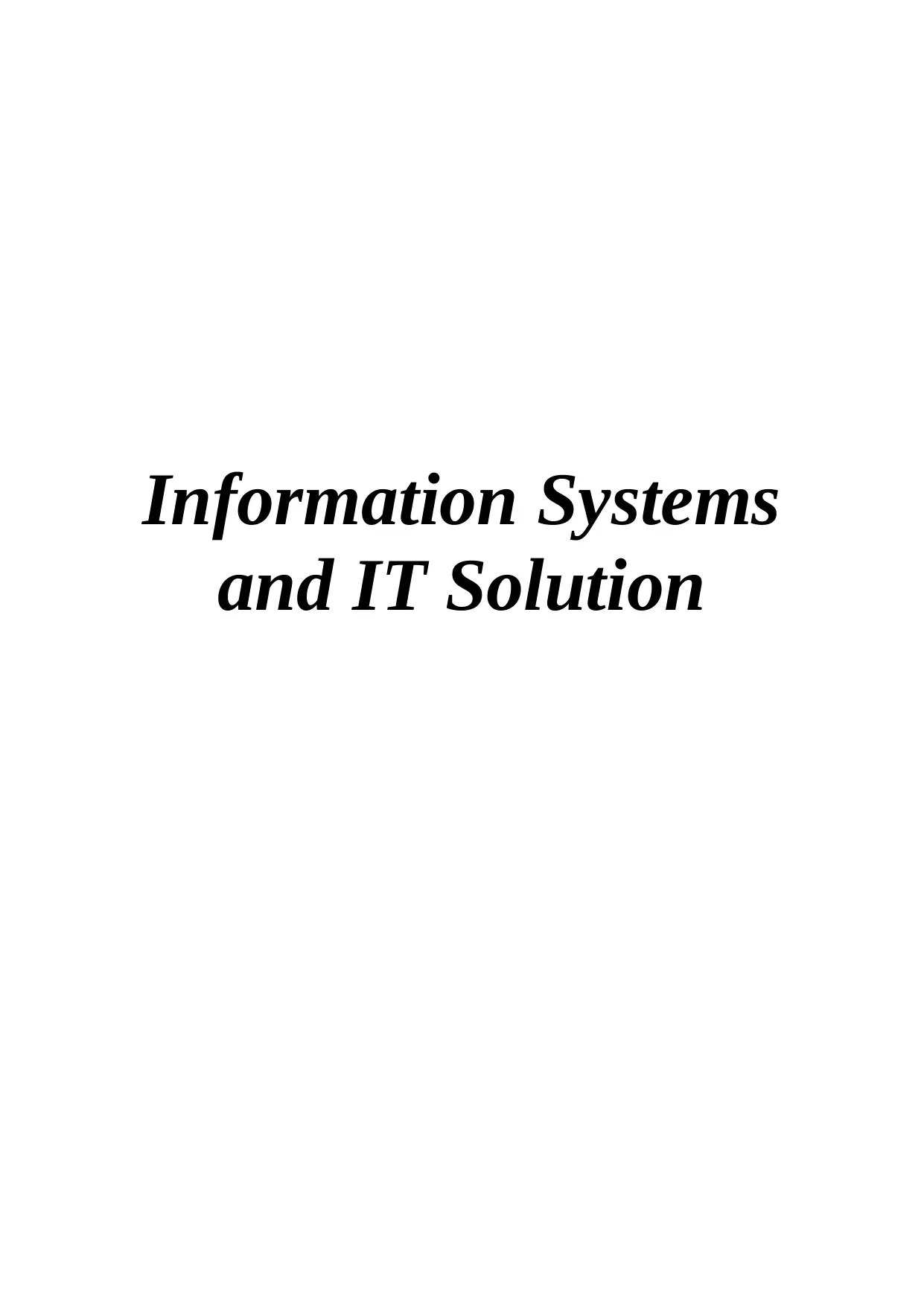
Information Systems
and IT Solution
and IT Solution
Paraphrase This Document
Need a fresh take? Get an instant paraphrase of this document with our AI Paraphraser
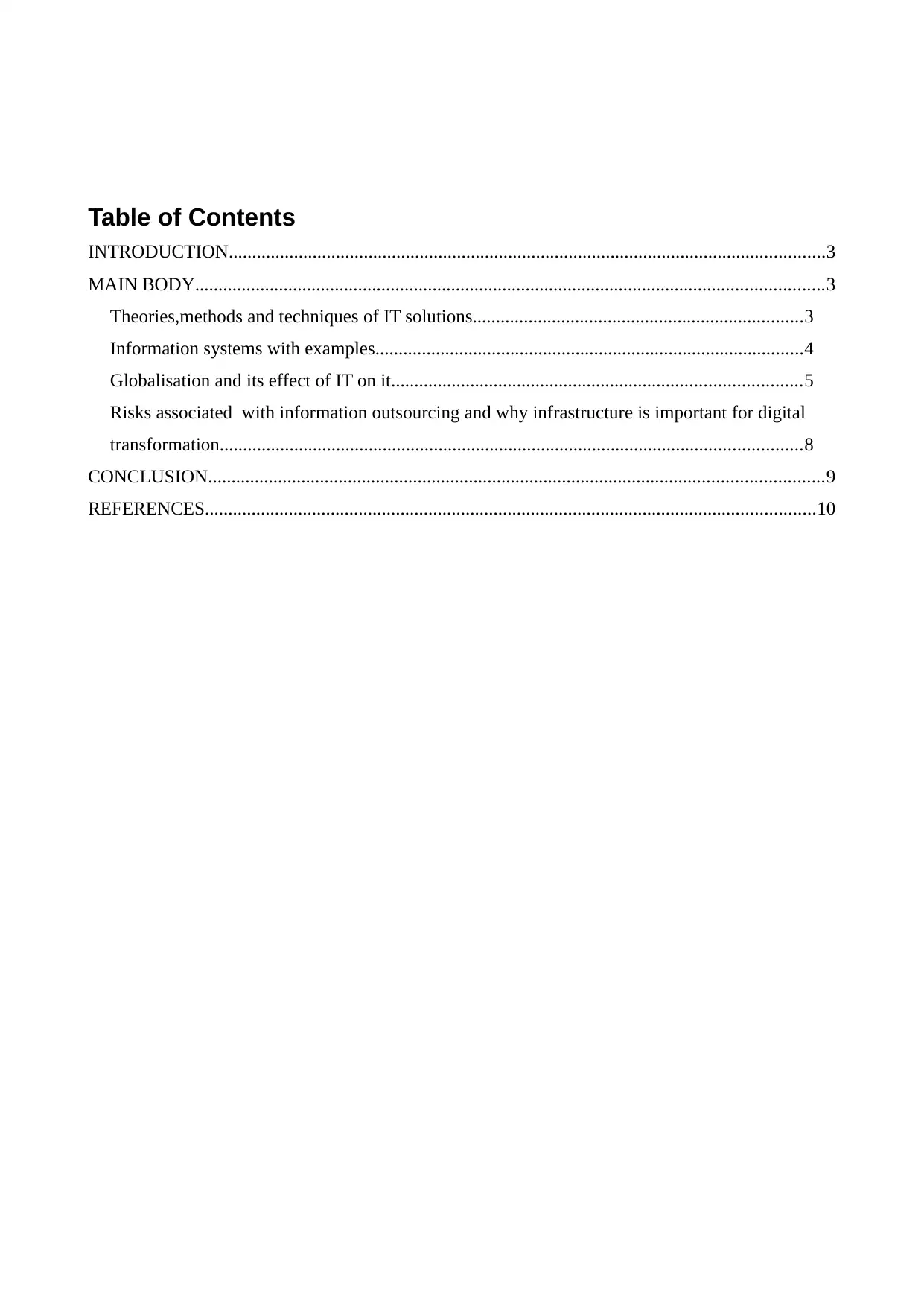
Table of Contents
INTRODUCTION................................................................................................................................3
MAIN BODY.......................................................................................................................................3
Theories,methods and techniques of IT solutions.......................................................................3
Information systems with examples............................................................................................4
Globalisation and its effect of IT on it........................................................................................5
Risks associated with information outsourcing and why infrastructure is important for digital
transformation.............................................................................................................................8
CONCLUSION....................................................................................................................................9
REFERENCES...................................................................................................................................10
INTRODUCTION................................................................................................................................3
MAIN BODY.......................................................................................................................................3
Theories,methods and techniques of IT solutions.......................................................................3
Information systems with examples............................................................................................4
Globalisation and its effect of IT on it........................................................................................5
Risks associated with information outsourcing and why infrastructure is important for digital
transformation.............................................................................................................................8
CONCLUSION....................................................................................................................................9
REFERENCES...................................................................................................................................10
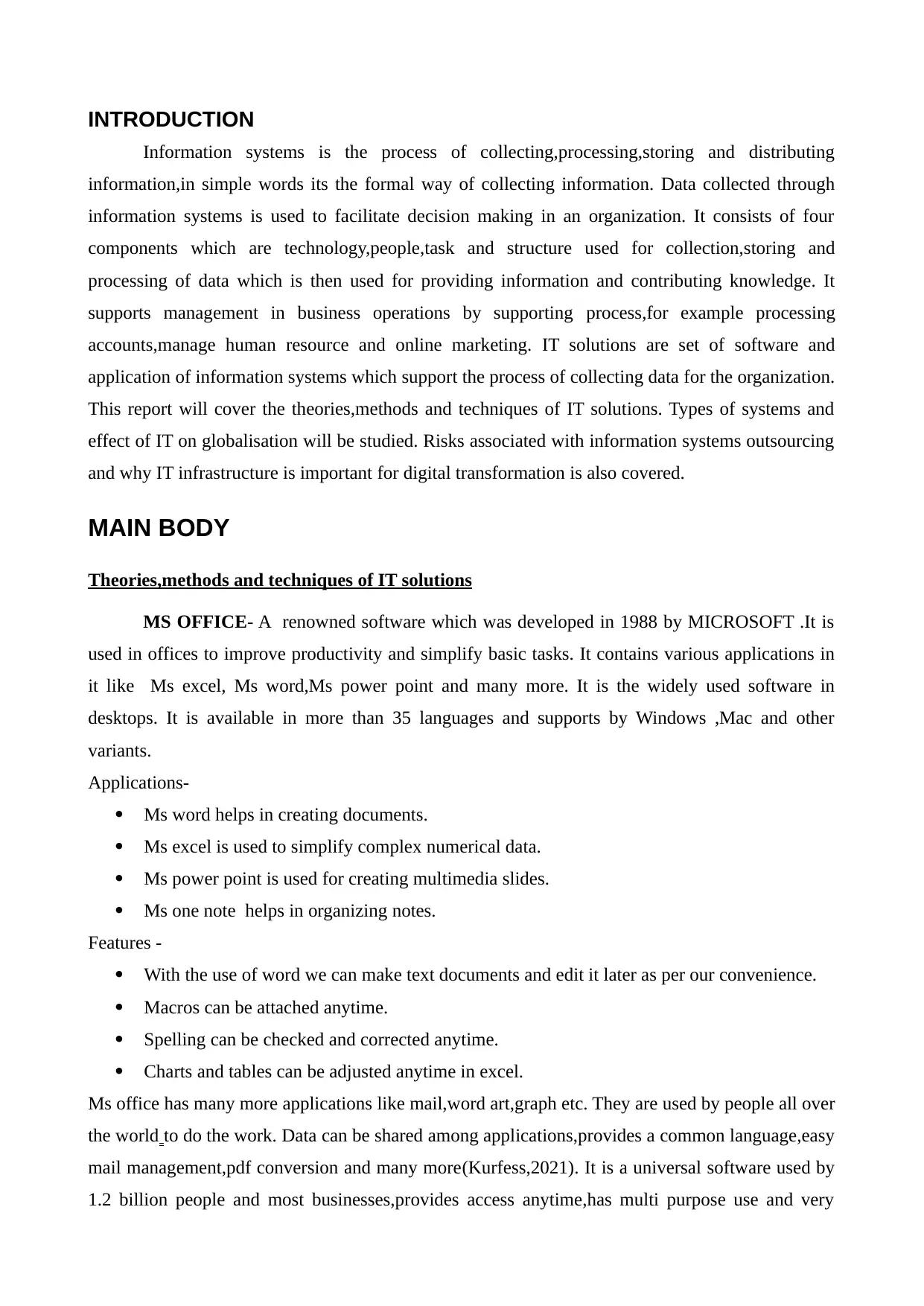
INTRODUCTION
Information systems is the process of collecting,processing,storing and distributing
information,in simple words its the formal way of collecting information. Data collected through
information systems is used to facilitate decision making in an organization. It consists of four
components which are technology,people,task and structure used for collection,storing and
processing of data which is then used for providing information and contributing knowledge. It
supports management in business operations by supporting process,for example processing
accounts,manage human resource and online marketing. IT solutions are set of software and
application of information systems which support the process of collecting data for the organization.
This report will cover the theories,methods and techniques of IT solutions. Types of systems and
effect of IT on globalisation will be studied. Risks associated with information systems outsourcing
and why IT infrastructure is important for digital transformation is also covered.
MAIN BODY
Theories,methods and techniques of IT solutions
MS OFFICE- A renowned software which was developed in 1988 by MICROSOFT .It is
used in offices to improve productivity and simplify basic tasks. It contains various applications in
it like Ms excel, Ms word,Ms power point and many more. It is the widely used software in
desktops. It is available in more than 35 languages and supports by Windows ,Mac and other
variants.
Applications-
Ms word helps in creating documents.
Ms excel is used to simplify complex numerical data.
Ms power point is used for creating multimedia slides.
Ms one note helps in organizing notes.
Features -
With the use of word we can make text documents and edit it later as per our convenience.
Macros can be attached anytime.
Spelling can be checked and corrected anytime.
Charts and tables can be adjusted anytime in excel.
Ms office has many more applications like mail,word art,graph etc. They are used by people all over
the world to do the work. Data can be shared among applications,provides a common language,easy
mail management,pdf conversion and many more(Kurfess,2021). It is a universal software used by
1.2 billion people and most businesses,provides access anytime,has multi purpose use and very
Information systems is the process of collecting,processing,storing and distributing
information,in simple words its the formal way of collecting information. Data collected through
information systems is used to facilitate decision making in an organization. It consists of four
components which are technology,people,task and structure used for collection,storing and
processing of data which is then used for providing information and contributing knowledge. It
supports management in business operations by supporting process,for example processing
accounts,manage human resource and online marketing. IT solutions are set of software and
application of information systems which support the process of collecting data for the organization.
This report will cover the theories,methods and techniques of IT solutions. Types of systems and
effect of IT on globalisation will be studied. Risks associated with information systems outsourcing
and why IT infrastructure is important for digital transformation is also covered.
MAIN BODY
Theories,methods and techniques of IT solutions
MS OFFICE- A renowned software which was developed in 1988 by MICROSOFT .It is
used in offices to improve productivity and simplify basic tasks. It contains various applications in
it like Ms excel, Ms word,Ms power point and many more. It is the widely used software in
desktops. It is available in more than 35 languages and supports by Windows ,Mac and other
variants.
Applications-
Ms word helps in creating documents.
Ms excel is used to simplify complex numerical data.
Ms power point is used for creating multimedia slides.
Ms one note helps in organizing notes.
Features -
With the use of word we can make text documents and edit it later as per our convenience.
Macros can be attached anytime.
Spelling can be checked and corrected anytime.
Charts and tables can be adjusted anytime in excel.
Ms office has many more applications like mail,word art,graph etc. They are used by people all over
the world to do the work. Data can be shared among applications,provides a common language,easy
mail management,pdf conversion and many more(Kurfess,2021). It is a universal software used by
1.2 billion people and most businesses,provides access anytime,has multi purpose use and very
⊘ This is a preview!⊘
Do you want full access?
Subscribe today to unlock all pages.

Trusted by 1+ million students worldwide
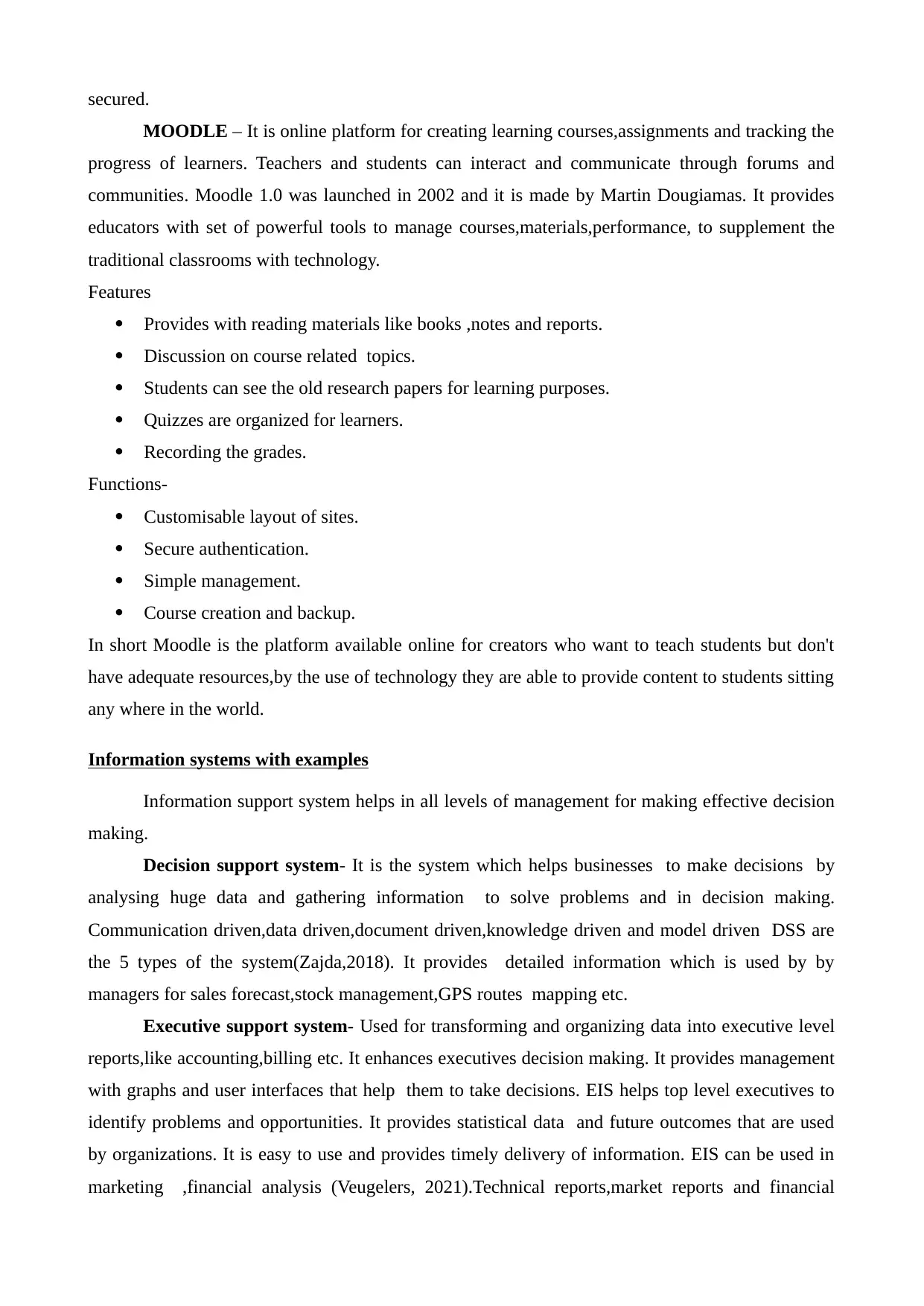
secured.
MOODLE – It is online platform for creating learning courses,assignments and tracking the
progress of learners. Teachers and students can interact and communicate through forums and
communities. Moodle 1.0 was launched in 2002 and it is made by Martin Dougiamas. It provides
educators with set of powerful tools to manage courses,materials,performance, to supplement the
traditional classrooms with technology.
Features
Provides with reading materials like books ,notes and reports.
Discussion on course related topics.
Students can see the old research papers for learning purposes.
Quizzes are organized for learners.
Recording the grades.
Functions-
Customisable layout of sites.
Secure authentication.
Simple management.
Course creation and backup.
In short Moodle is the platform available online for creators who want to teach students but don't
have adequate resources,by the use of technology they are able to provide content to students sitting
any where in the world.
Information systems with examples
Information support system helps in all levels of management for making effective decision
making.
Decision support system- It is the system which helps businesses to make decisions by
analysing huge data and gathering information to solve problems and in decision making.
Communication driven,data driven,document driven,knowledge driven and model driven DSS are
the 5 types of the system(Zajda,2018). It provides detailed information which is used by by
managers for sales forecast,stock management,GPS routes mapping etc.
Executive support system- Used for transforming and organizing data into executive level
reports,like accounting,billing etc. It enhances executives decision making. It provides management
with graphs and user interfaces that help them to take decisions. EIS helps top level executives to
identify problems and opportunities. It provides statistical data and future outcomes that are used
by organizations. It is easy to use and provides timely delivery of information. EIS can be used in
marketing ,financial analysis (Veugelers, 2021).Technical reports,market reports and financial
MOODLE – It is online platform for creating learning courses,assignments and tracking the
progress of learners. Teachers and students can interact and communicate through forums and
communities. Moodle 1.0 was launched in 2002 and it is made by Martin Dougiamas. It provides
educators with set of powerful tools to manage courses,materials,performance, to supplement the
traditional classrooms with technology.
Features
Provides with reading materials like books ,notes and reports.
Discussion on course related topics.
Students can see the old research papers for learning purposes.
Quizzes are organized for learners.
Recording the grades.
Functions-
Customisable layout of sites.
Secure authentication.
Simple management.
Course creation and backup.
In short Moodle is the platform available online for creators who want to teach students but don't
have adequate resources,by the use of technology they are able to provide content to students sitting
any where in the world.
Information systems with examples
Information support system helps in all levels of management for making effective decision
making.
Decision support system- It is the system which helps businesses to make decisions by
analysing huge data and gathering information to solve problems and in decision making.
Communication driven,data driven,document driven,knowledge driven and model driven DSS are
the 5 types of the system(Zajda,2018). It provides detailed information which is used by by
managers for sales forecast,stock management,GPS routes mapping etc.
Executive support system- Used for transforming and organizing data into executive level
reports,like accounting,billing etc. It enhances executives decision making. It provides management
with graphs and user interfaces that help them to take decisions. EIS helps top level executives to
identify problems and opportunities. It provides statistical data and future outcomes that are used
by organizations. It is easy to use and provides timely delivery of information. EIS can be used in
marketing ,financial analysis (Veugelers, 2021).Technical reports,market reports and financial
Paraphrase This Document
Need a fresh take? Get an instant paraphrase of this document with our AI Paraphraser
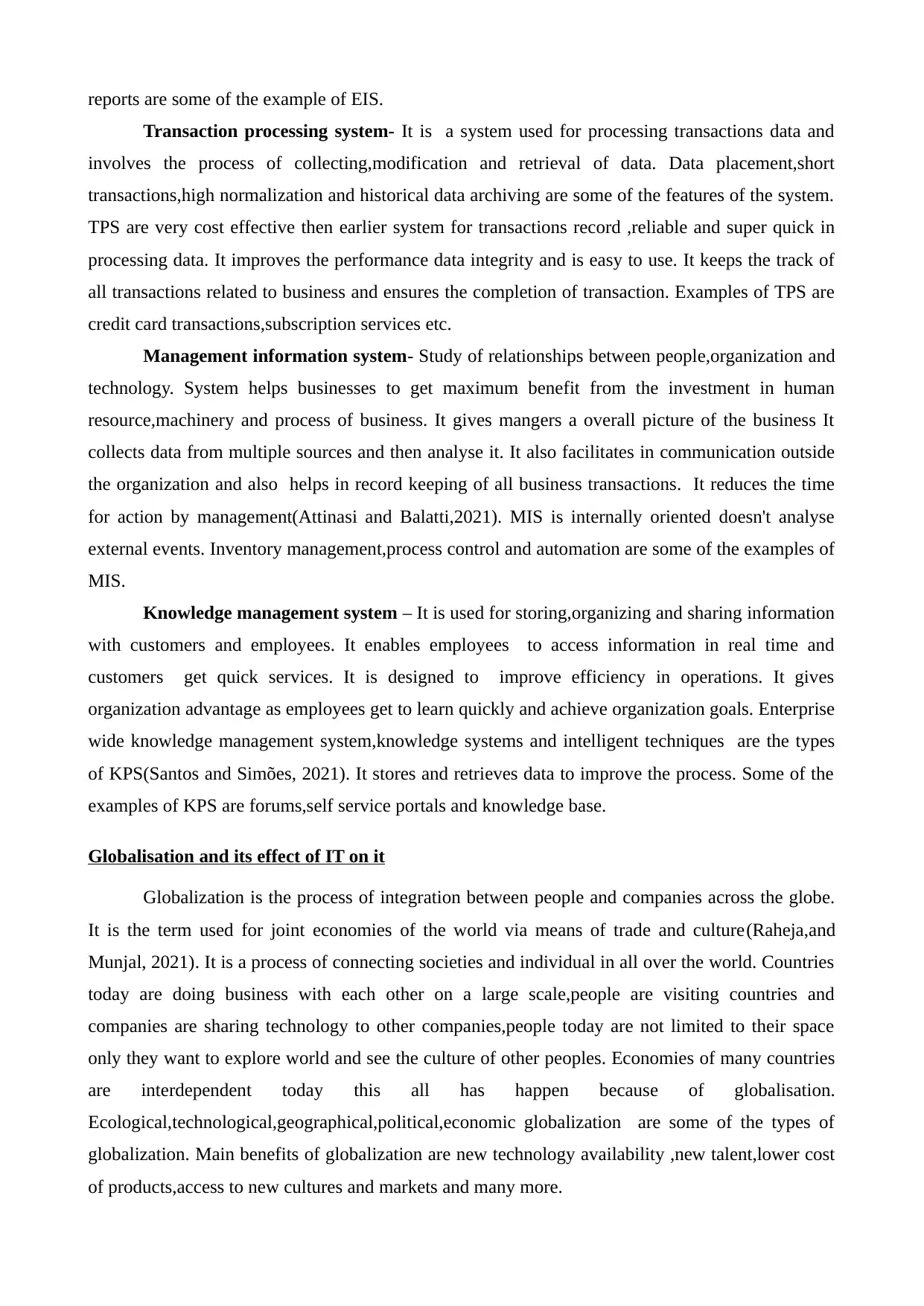
reports are some of the example of EIS.
Transaction processing system- It is a system used for processing transactions data and
involves the process of collecting,modification and retrieval of data. Data placement,short
transactions,high normalization and historical data archiving are some of the features of the system.
TPS are very cost effective then earlier system for transactions record ,reliable and super quick in
processing data. It improves the performance data integrity and is easy to use. It keeps the track of
all transactions related to business and ensures the completion of transaction. Examples of TPS are
credit card transactions,subscription services etc.
Management information system- Study of relationships between people,organization and
technology. System helps businesses to get maximum benefit from the investment in human
resource,machinery and process of business. It gives mangers a overall picture of the business It
collects data from multiple sources and then analyse it. It also facilitates in communication outside
the organization and also helps in record keeping of all business transactions. It reduces the time
for action by management(Attinasi and Balatti,2021). MIS is internally oriented doesn't analyse
external events. Inventory management,process control and automation are some of the examples of
MIS.
Knowledge management system – It is used for storing,organizing and sharing information
with customers and employees. It enables employees to access information in real time and
customers get quick services. It is designed to improve efficiency in operations. It gives
organization advantage as employees get to learn quickly and achieve organization goals. Enterprise
wide knowledge management system,knowledge systems and intelligent techniques are the types
of KPS(Santos and Simões, 2021). It stores and retrieves data to improve the process. Some of the
examples of KPS are forums,self service portals and knowledge base.
Globalisation and its effect of IT on it
Globalization is the process of integration between people and companies across the globe.
It is the term used for joint economies of the world via means of trade and culture(Raheja,and
Munjal, 2021). It is a process of connecting societies and individual in all over the world. Countries
today are doing business with each other on a large scale,people are visiting countries and
companies are sharing technology to other companies,people today are not limited to their space
only they want to explore world and see the culture of other peoples. Economies of many countries
are interdependent today this all has happen because of globalisation.
Ecological,technological,geographical,political,economic globalization are some of the types of
globalization. Main benefits of globalization are new technology availability ,new talent,lower cost
of products,access to new cultures and markets and many more.
Transaction processing system- It is a system used for processing transactions data and
involves the process of collecting,modification and retrieval of data. Data placement,short
transactions,high normalization and historical data archiving are some of the features of the system.
TPS are very cost effective then earlier system for transactions record ,reliable and super quick in
processing data. It improves the performance data integrity and is easy to use. It keeps the track of
all transactions related to business and ensures the completion of transaction. Examples of TPS are
credit card transactions,subscription services etc.
Management information system- Study of relationships between people,organization and
technology. System helps businesses to get maximum benefit from the investment in human
resource,machinery and process of business. It gives mangers a overall picture of the business It
collects data from multiple sources and then analyse it. It also facilitates in communication outside
the organization and also helps in record keeping of all business transactions. It reduces the time
for action by management(Attinasi and Balatti,2021). MIS is internally oriented doesn't analyse
external events. Inventory management,process control and automation are some of the examples of
MIS.
Knowledge management system – It is used for storing,organizing and sharing information
with customers and employees. It enables employees to access information in real time and
customers get quick services. It is designed to improve efficiency in operations. It gives
organization advantage as employees get to learn quickly and achieve organization goals. Enterprise
wide knowledge management system,knowledge systems and intelligent techniques are the types
of KPS(Santos and Simões, 2021). It stores and retrieves data to improve the process. Some of the
examples of KPS are forums,self service portals and knowledge base.
Globalisation and its effect of IT on it
Globalization is the process of integration between people and companies across the globe.
It is the term used for joint economies of the world via means of trade and culture(Raheja,and
Munjal, 2021). It is a process of connecting societies and individual in all over the world. Countries
today are doing business with each other on a large scale,people are visiting countries and
companies are sharing technology to other companies,people today are not limited to their space
only they want to explore world and see the culture of other peoples. Economies of many countries
are interdependent today this all has happen because of globalisation.
Ecological,technological,geographical,political,economic globalization are some of the types of
globalization. Main benefits of globalization are new technology availability ,new talent,lower cost
of products,access to new cultures and markets and many more.
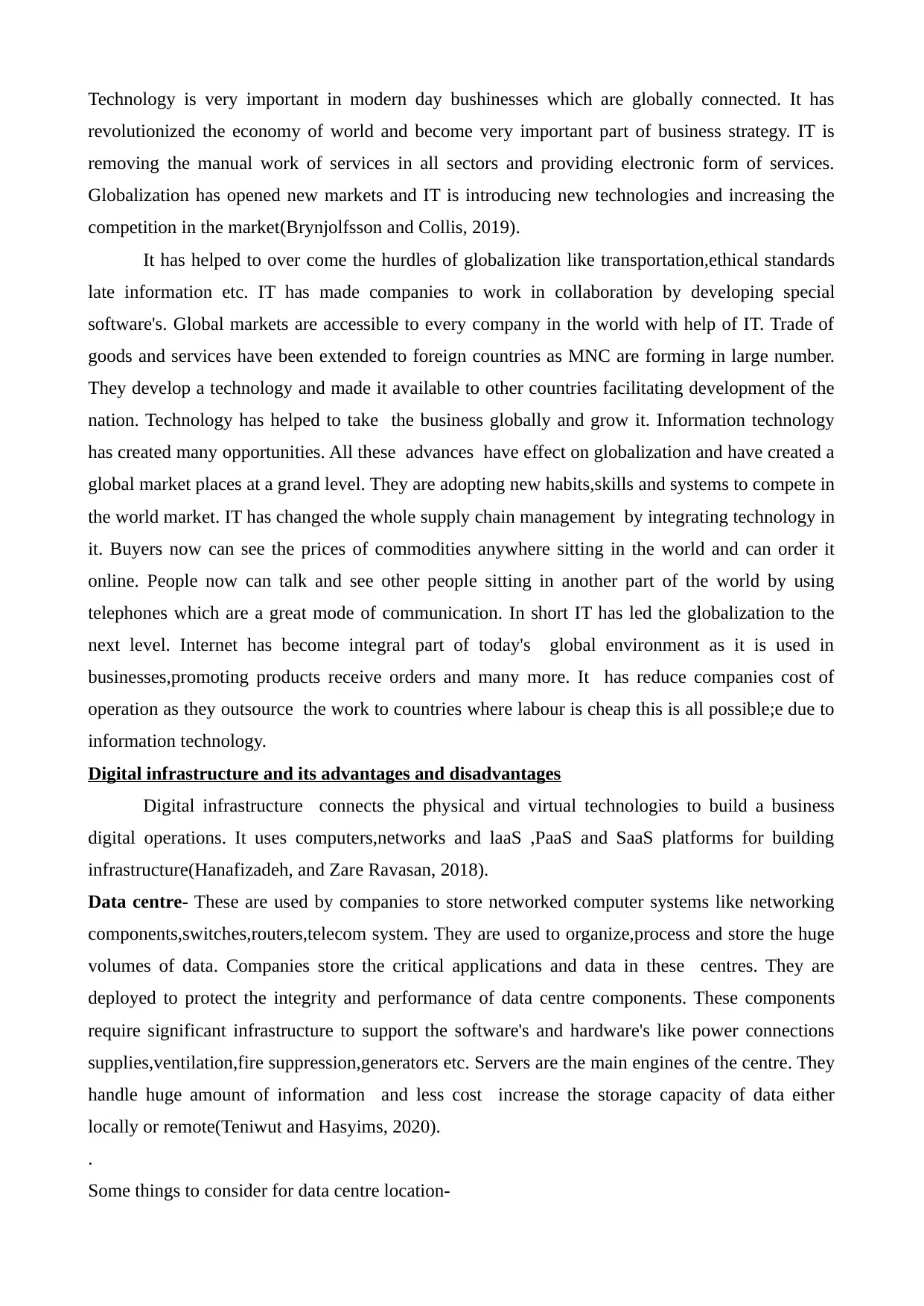
Technology is very important in modern day bushinesses which are globally connected. It has
revolutionized the economy of world and become very important part of business strategy. IT is
removing the manual work of services in all sectors and providing electronic form of services.
Globalization has opened new markets and IT is introducing new technologies and increasing the
competition in the market(Brynjolfsson and Collis, 2019).
It has helped to over come the hurdles of globalization like transportation,ethical standards
late information etc. IT has made companies to work in collaboration by developing special
software's. Global markets are accessible to every company in the world with help of IT. Trade of
goods and services have been extended to foreign countries as MNC are forming in large number.
They develop a technology and made it available to other countries facilitating development of the
nation. Technology has helped to take the business globally and grow it. Information technology
has created many opportunities. All these advances have effect on globalization and have created a
global market places at a grand level. They are adopting new habits,skills and systems to compete in
the world market. IT has changed the whole supply chain management by integrating technology in
it. Buyers now can see the prices of commodities anywhere sitting in the world and can order it
online. People now can talk and see other people sitting in another part of the world by using
telephones which are a great mode of communication. In short IT has led the globalization to the
next level. Internet has become integral part of today's global environment as it is used in
businesses,promoting products receive orders and many more. It has reduce companies cost of
operation as they outsource the work to countries where labour is cheap this is all possible;e due to
information technology.
Digital infrastructure and its advantages and disadvantages
Digital infrastructure connects the physical and virtual technologies to build a business
digital operations. It uses computers,networks and laaS ,PaaS and SaaS platforms for building
infrastructure(Hanafizadeh, and Zare Ravasan, 2018).
Data centre- These are used by companies to store networked computer systems like networking
components,switches,routers,telecom system. They are used to organize,process and store the huge
volumes of data. Companies store the critical applications and data in these centres. They are
deployed to protect the integrity and performance of data centre components. These components
require significant infrastructure to support the software's and hardware's like power connections
supplies,ventilation,fire suppression,generators etc. Servers are the main engines of the centre. They
handle huge amount of information and less cost increase the storage capacity of data either
locally or remote(Teniwut and Hasyims, 2020).
.
Some things to consider for data centre location-
revolutionized the economy of world and become very important part of business strategy. IT is
removing the manual work of services in all sectors and providing electronic form of services.
Globalization has opened new markets and IT is introducing new technologies and increasing the
competition in the market(Brynjolfsson and Collis, 2019).
It has helped to over come the hurdles of globalization like transportation,ethical standards
late information etc. IT has made companies to work in collaboration by developing special
software's. Global markets are accessible to every company in the world with help of IT. Trade of
goods and services have been extended to foreign countries as MNC are forming in large number.
They develop a technology and made it available to other countries facilitating development of the
nation. Technology has helped to take the business globally and grow it. Information technology
has created many opportunities. All these advances have effect on globalization and have created a
global market places at a grand level. They are adopting new habits,skills and systems to compete in
the world market. IT has changed the whole supply chain management by integrating technology in
it. Buyers now can see the prices of commodities anywhere sitting in the world and can order it
online. People now can talk and see other people sitting in another part of the world by using
telephones which are a great mode of communication. In short IT has led the globalization to the
next level. Internet has become integral part of today's global environment as it is used in
businesses,promoting products receive orders and many more. It has reduce companies cost of
operation as they outsource the work to countries where labour is cheap this is all possible;e due to
information technology.
Digital infrastructure and its advantages and disadvantages
Digital infrastructure connects the physical and virtual technologies to build a business
digital operations. It uses computers,networks and laaS ,PaaS and SaaS platforms for building
infrastructure(Hanafizadeh, and Zare Ravasan, 2018).
Data centre- These are used by companies to store networked computer systems like networking
components,switches,routers,telecom system. They are used to organize,process and store the huge
volumes of data. Companies store the critical applications and data in these centres. They are
deployed to protect the integrity and performance of data centre components. These components
require significant infrastructure to support the software's and hardware's like power connections
supplies,ventilation,fire suppression,generators etc. Servers are the main engines of the centre. They
handle huge amount of information and less cost increase the storage capacity of data either
locally or remote(Teniwut and Hasyims, 2020).
.
Some things to consider for data centre location-
⊘ This is a preview!⊘
Do you want full access?
Subscribe today to unlock all pages.

Trusted by 1+ million students worldwide
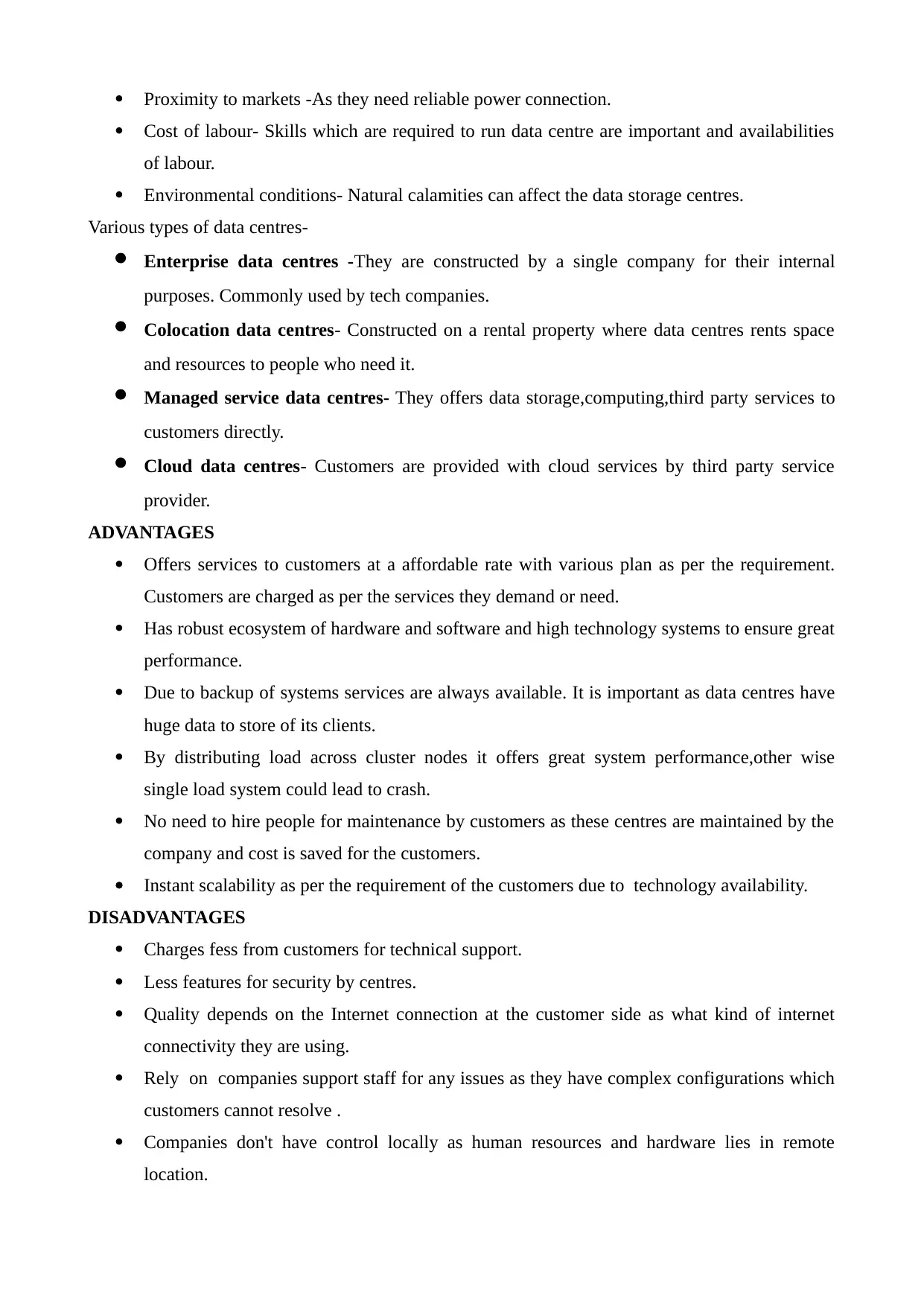
Proximity to markets -As they need reliable power connection.
Cost of labour- Skills which are required to run data centre are important and availabilities
of labour.
Environmental conditions- Natural calamities can affect the data storage centres.
Various types of data centres-
Enterprise data centres -They are constructed by a single company for their internal
purposes. Commonly used by tech companies.
Colocation data centres- Constructed on a rental property where data centres rents space
and resources to people who need it.
Managed service data centres- They offers data storage,computing,third party services to
customers directly.
Cloud data centres- Customers are provided with cloud services by third party service
provider.
ADVANTAGES
Offers services to customers at a affordable rate with various plan as per the requirement.
Customers are charged as per the services they demand or need.
Has robust ecosystem of hardware and software and high technology systems to ensure great
performance.
Due to backup of systems services are always available. It is important as data centres have
huge data to store of its clients.
By distributing load across cluster nodes it offers great system performance,other wise
single load system could lead to crash.
No need to hire people for maintenance by customers as these centres are maintained by the
company and cost is saved for the customers.
Instant scalability as per the requirement of the customers due to technology availability.
DISADVANTAGES
Charges fess from customers for technical support.
Less features for security by centres.
Quality depends on the Internet connection at the customer side as what kind of internet
connectivity they are using.
Rely on companies support staff for any issues as they have complex configurations which
customers cannot resolve .
Companies don't have control locally as human resources and hardware lies in remote
location.
Cost of labour- Skills which are required to run data centre are important and availabilities
of labour.
Environmental conditions- Natural calamities can affect the data storage centres.
Various types of data centres-
Enterprise data centres -They are constructed by a single company for their internal
purposes. Commonly used by tech companies.
Colocation data centres- Constructed on a rental property where data centres rents space
and resources to people who need it.
Managed service data centres- They offers data storage,computing,third party services to
customers directly.
Cloud data centres- Customers are provided with cloud services by third party service
provider.
ADVANTAGES
Offers services to customers at a affordable rate with various plan as per the requirement.
Customers are charged as per the services they demand or need.
Has robust ecosystem of hardware and software and high technology systems to ensure great
performance.
Due to backup of systems services are always available. It is important as data centres have
huge data to store of its clients.
By distributing load across cluster nodes it offers great system performance,other wise
single load system could lead to crash.
No need to hire people for maintenance by customers as these centres are maintained by the
company and cost is saved for the customers.
Instant scalability as per the requirement of the customers due to technology availability.
DISADVANTAGES
Charges fess from customers for technical support.
Less features for security by centres.
Quality depends on the Internet connection at the customer side as what kind of internet
connectivity they are using.
Rely on companies support staff for any issues as they have complex configurations which
customers cannot resolve .
Companies don't have control locally as human resources and hardware lies in remote
location.
Paraphrase This Document
Need a fresh take? Get an instant paraphrase of this document with our AI Paraphraser
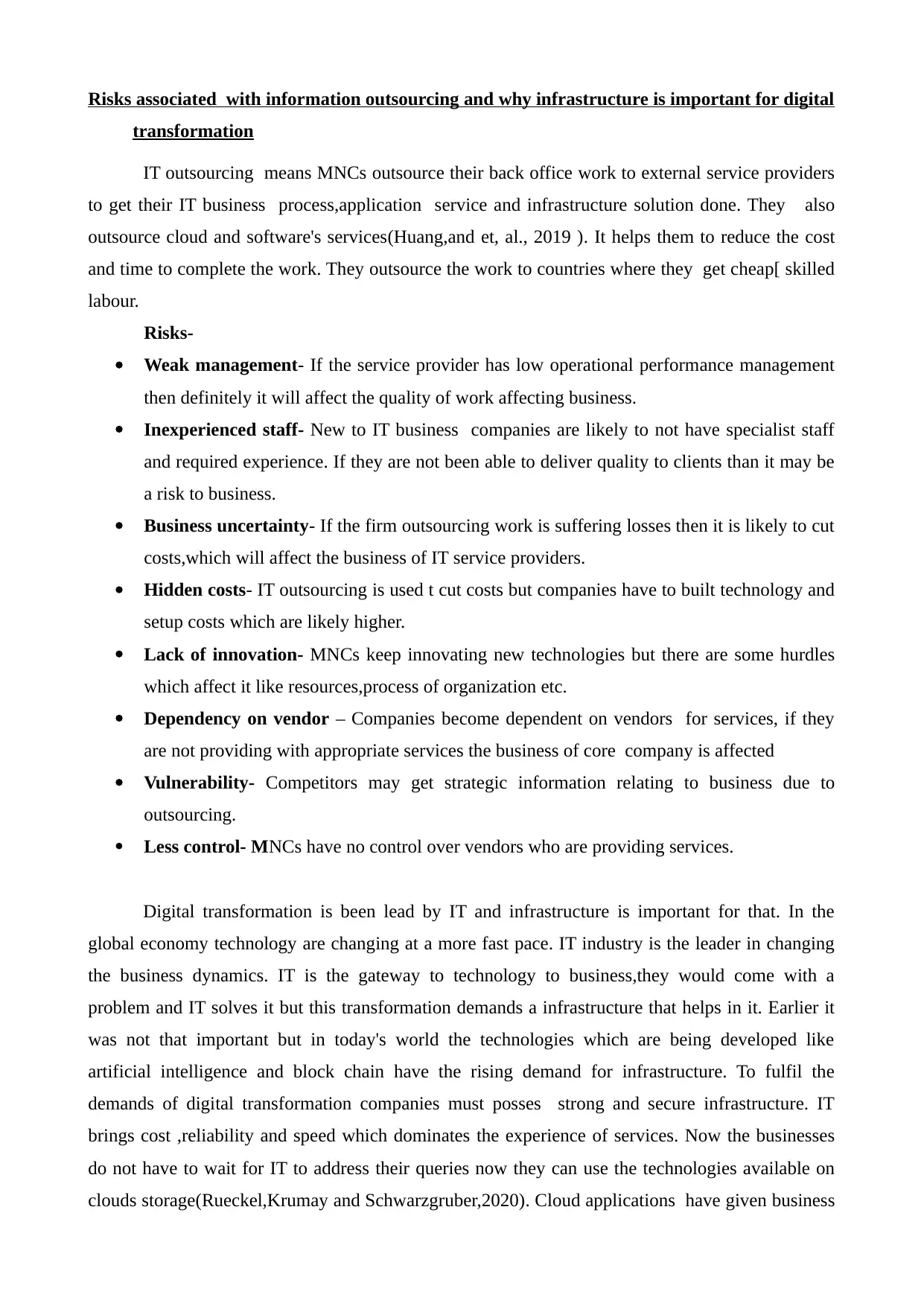
Risks associated with information outsourcing and why infrastructure is important for digital
transformation
IT outsourcing means MNCs outsource their back office work to external service providers
to get their IT business process,application service and infrastructure solution done. They also
outsource cloud and software's services(Huang,and et, al., 2019 ). It helps them to reduce the cost
and time to complete the work. They outsource the work to countries where they get cheap[ skilled
labour.
Risks-
Weak management- If the service provider has low operational performance management
then definitely it will affect the quality of work affecting business.
Inexperienced staff- New to IT business companies are likely to not have specialist staff
and required experience. If they are not been able to deliver quality to clients than it may be
a risk to business.
Business uncertainty- If the firm outsourcing work is suffering losses then it is likely to cut
costs,which will affect the business of IT service providers.
Hidden costs- IT outsourcing is used t cut costs but companies have to built technology and
setup costs which are likely higher.
Lack of innovation- MNCs keep innovating new technologies but there are some hurdles
which affect it like resources,process of organization etc.
Dependency on vendor – Companies become dependent on vendors for services, if they
are not providing with appropriate services the business of core company is affected
Vulnerability- Competitors may get strategic information relating to business due to
outsourcing.
Less control- MNCs have no control over vendors who are providing services.
Digital transformation is been lead by IT and infrastructure is important for that. In the
global economy technology are changing at a more fast pace. IT industry is the leader in changing
the business dynamics. IT is the gateway to technology to business,they would come with a
problem and IT solves it but this transformation demands a infrastructure that helps in it. Earlier it
was not that important but in today's world the technologies which are being developed like
artificial intelligence and block chain have the rising demand for infrastructure. To fulfil the
demands of digital transformation companies must posses strong and secure infrastructure. IT
brings cost ,reliability and speed which dominates the experience of services. Now the businesses
do not have to wait for IT to address their queries now they can use the technologies available on
clouds storage(Rueckel,Krumay and Schwarzgruber,2020). Cloud applications have given business
transformation
IT outsourcing means MNCs outsource their back office work to external service providers
to get their IT business process,application service and infrastructure solution done. They also
outsource cloud and software's services(Huang,and et, al., 2019 ). It helps them to reduce the cost
and time to complete the work. They outsource the work to countries where they get cheap[ skilled
labour.
Risks-
Weak management- If the service provider has low operational performance management
then definitely it will affect the quality of work affecting business.
Inexperienced staff- New to IT business companies are likely to not have specialist staff
and required experience. If they are not been able to deliver quality to clients than it may be
a risk to business.
Business uncertainty- If the firm outsourcing work is suffering losses then it is likely to cut
costs,which will affect the business of IT service providers.
Hidden costs- IT outsourcing is used t cut costs but companies have to built technology and
setup costs which are likely higher.
Lack of innovation- MNCs keep innovating new technologies but there are some hurdles
which affect it like resources,process of organization etc.
Dependency on vendor – Companies become dependent on vendors for services, if they
are not providing with appropriate services the business of core company is affected
Vulnerability- Competitors may get strategic information relating to business due to
outsourcing.
Less control- MNCs have no control over vendors who are providing services.
Digital transformation is been lead by IT and infrastructure is important for that. In the
global economy technology are changing at a more fast pace. IT industry is the leader in changing
the business dynamics. IT is the gateway to technology to business,they would come with a
problem and IT solves it but this transformation demands a infrastructure that helps in it. Earlier it
was not that important but in today's world the technologies which are being developed like
artificial intelligence and block chain have the rising demand for infrastructure. To fulfil the
demands of digital transformation companies must posses strong and secure infrastructure. IT
brings cost ,reliability and speed which dominates the experience of services. Now the businesses
do not have to wait for IT to address their queries now they can use the technologies available on
clouds storage(Rueckel,Krumay and Schwarzgruber,2020). Cloud applications have given business
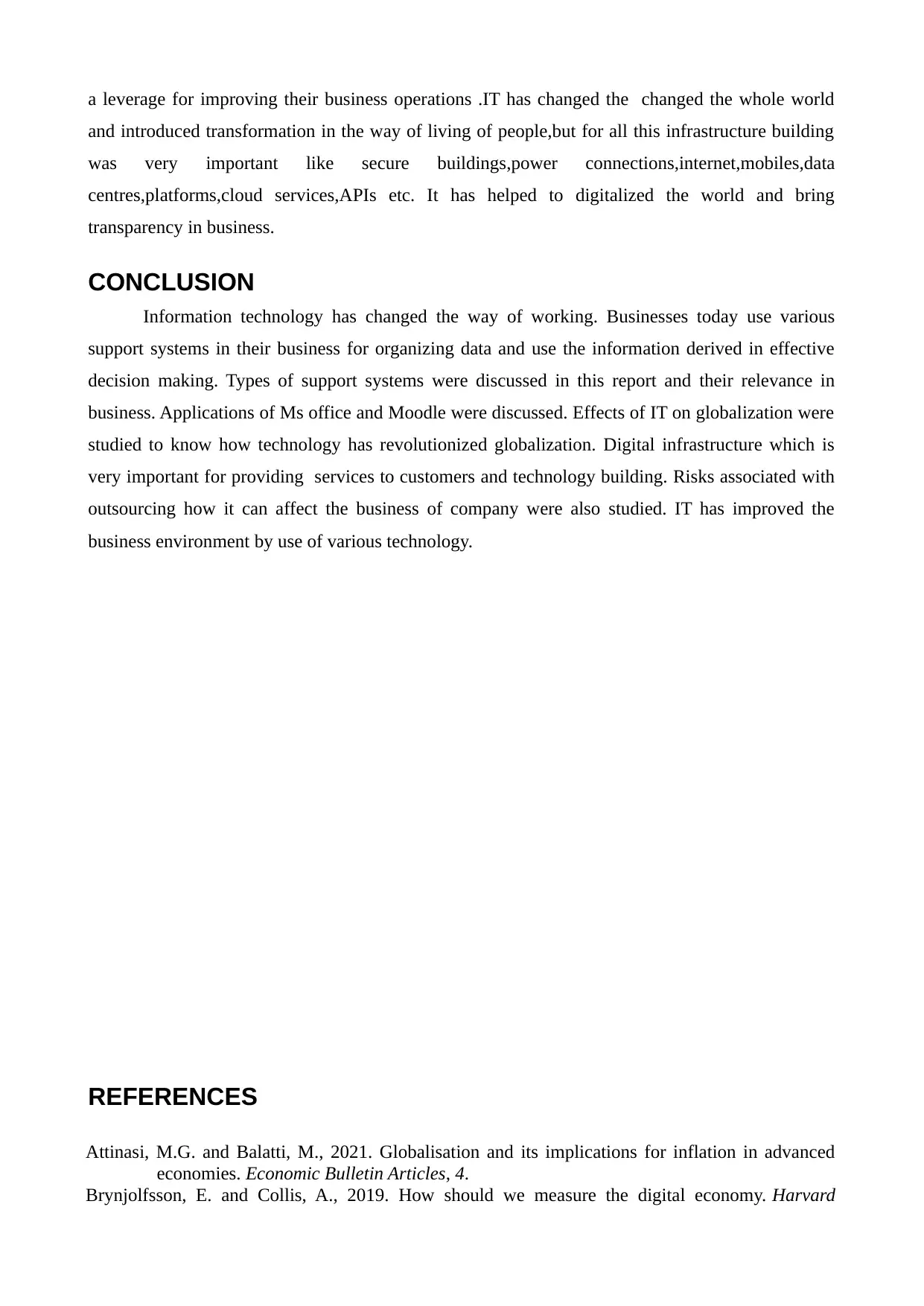
a leverage for improving their business operations .IT has changed the changed the whole world
and introduced transformation in the way of living of people,but for all this infrastructure building
was very important like secure buildings,power connections,internet,mobiles,data
centres,platforms,cloud services,APIs etc. It has helped to digitalized the world and bring
transparency in business.
CONCLUSION
Information technology has changed the way of working. Businesses today use various
support systems in their business for organizing data and use the information derived in effective
decision making. Types of support systems were discussed in this report and their relevance in
business. Applications of Ms office and Moodle were discussed. Effects of IT on globalization were
studied to know how technology has revolutionized globalization. Digital infrastructure which is
very important for providing services to customers and technology building. Risks associated with
outsourcing how it can affect the business of company were also studied. IT has improved the
business environment by use of various technology.
REFERENCES
Attinasi, M.G. and Balatti, M., 2021. Globalisation and its implications for inflation in advanced
economies. Economic Bulletin Articles, 4.
Brynjolfsson, E. and Collis, A., 2019. How should we measure the digital economy. Harvard
and introduced transformation in the way of living of people,but for all this infrastructure building
was very important like secure buildings,power connections,internet,mobiles,data
centres,platforms,cloud services,APIs etc. It has helped to digitalized the world and bring
transparency in business.
CONCLUSION
Information technology has changed the way of working. Businesses today use various
support systems in their business for organizing data and use the information derived in effective
decision making. Types of support systems were discussed in this report and their relevance in
business. Applications of Ms office and Moodle were discussed. Effects of IT on globalization were
studied to know how technology has revolutionized globalization. Digital infrastructure which is
very important for providing services to customers and technology building. Risks associated with
outsourcing how it can affect the business of company were also studied. IT has improved the
business environment by use of various technology.
REFERENCES
Attinasi, M.G. and Balatti, M., 2021. Globalisation and its implications for inflation in advanced
economies. Economic Bulletin Articles, 4.
Brynjolfsson, E. and Collis, A., 2019. How should we measure the digital economy. Harvard
⊘ This is a preview!⊘
Do you want full access?
Subscribe today to unlock all pages.

Trusted by 1+ million students worldwide
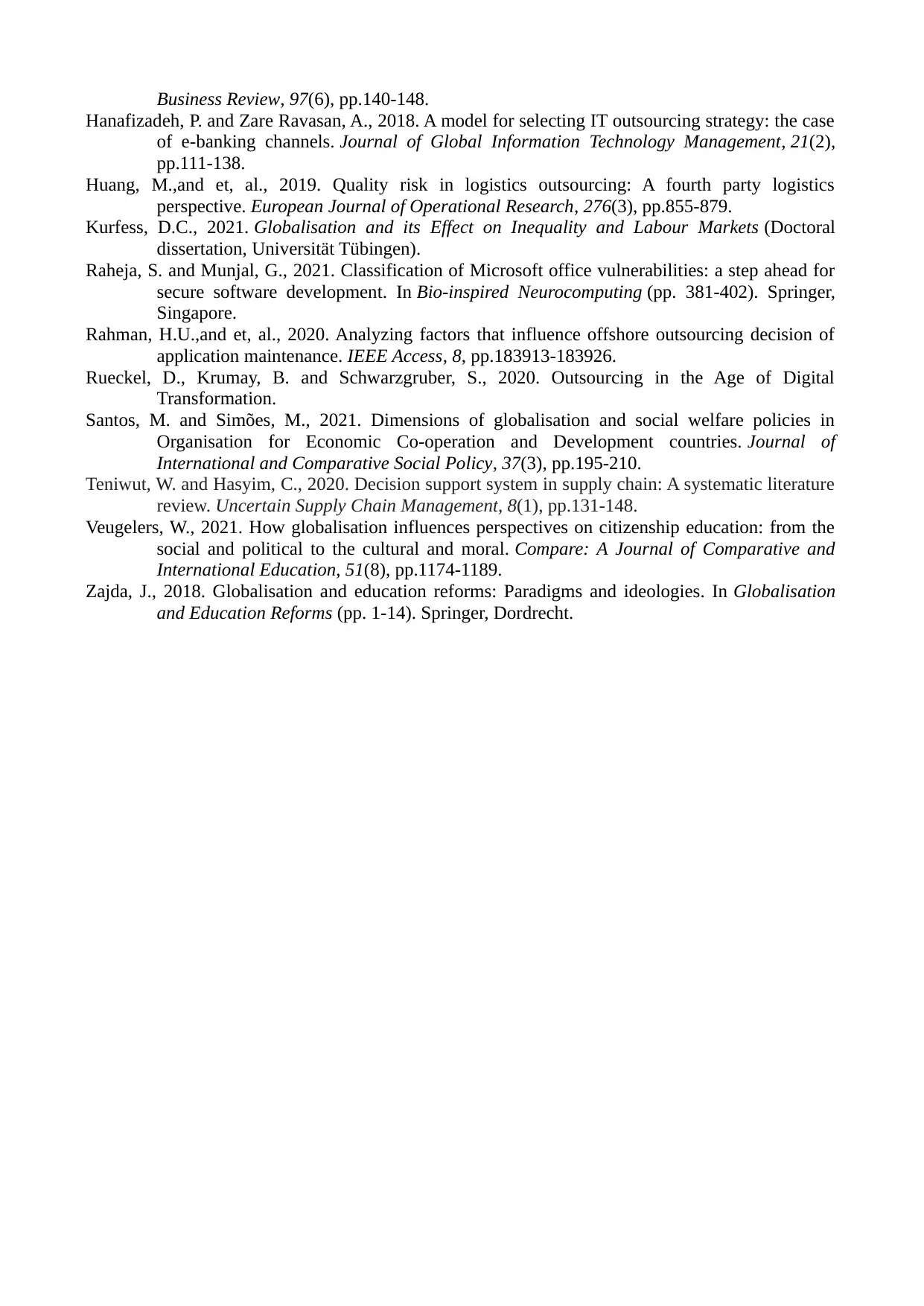
Business Review, 97(6), pp.140-148.
Hanafizadeh, P. and Zare Ravasan, A., 2018. A model for selecting IT outsourcing strategy: the case
of e-banking channels. Journal of Global Information Technology Management, 21(2),
pp.111-138.
Huang, M.,and et, al., 2019. Quality risk in logistics outsourcing: A fourth party logistics
perspective. European Journal of Operational Research, 276(3), pp.855-879.
Kurfess, D.C., 2021. Globalisation and its Effect on Inequality and Labour Markets (Doctoral
dissertation, Universität Tübingen).
Raheja, S. and Munjal, G., 2021. Classification of Microsoft office vulnerabilities: a step ahead for
secure software development. In Bio-inspired Neurocomputing (pp. 381-402). Springer,
Singapore.
Rahman, H.U.,and et, al., 2020. Analyzing factors that influence offshore outsourcing decision of
application maintenance. IEEE Access, 8, pp.183913-183926.
Rueckel, D., Krumay, B. and Schwarzgruber, S., 2020. Outsourcing in the Age of Digital
Transformation.
Santos, M. and Simões, M., 2021. Dimensions of globalisation and social welfare policies in
Organisation for Economic Co-operation and Development countries. Journal of
International and Comparative Social Policy, 37(3), pp.195-210.
Teniwut, W. and Hasyim, C., 2020. Decision support system in supply chain: A systematic literature
review. Uncertain Supply Chain Management, 8(1), pp.131-148.
Veugelers, W., 2021. How globalisation influences perspectives on citizenship education: from the
social and political to the cultural and moral. Compare: A Journal of Comparative and
International Education, 51(8), pp.1174-1189.
Zajda, J., 2018. Globalisation and education reforms: Paradigms and ideologies. In Globalisation
and Education Reforms (pp. 1-14). Springer, Dordrecht.
Hanafizadeh, P. and Zare Ravasan, A., 2018. A model for selecting IT outsourcing strategy: the case
of e-banking channels. Journal of Global Information Technology Management, 21(2),
pp.111-138.
Huang, M.,and et, al., 2019. Quality risk in logistics outsourcing: A fourth party logistics
perspective. European Journal of Operational Research, 276(3), pp.855-879.
Kurfess, D.C., 2021. Globalisation and its Effect on Inequality and Labour Markets (Doctoral
dissertation, Universität Tübingen).
Raheja, S. and Munjal, G., 2021. Classification of Microsoft office vulnerabilities: a step ahead for
secure software development. In Bio-inspired Neurocomputing (pp. 381-402). Springer,
Singapore.
Rahman, H.U.,and et, al., 2020. Analyzing factors that influence offshore outsourcing decision of
application maintenance. IEEE Access, 8, pp.183913-183926.
Rueckel, D., Krumay, B. and Schwarzgruber, S., 2020. Outsourcing in the Age of Digital
Transformation.
Santos, M. and Simões, M., 2021. Dimensions of globalisation and social welfare policies in
Organisation for Economic Co-operation and Development countries. Journal of
International and Comparative Social Policy, 37(3), pp.195-210.
Teniwut, W. and Hasyim, C., 2020. Decision support system in supply chain: A systematic literature
review. Uncertain Supply Chain Management, 8(1), pp.131-148.
Veugelers, W., 2021. How globalisation influences perspectives on citizenship education: from the
social and political to the cultural and moral. Compare: A Journal of Comparative and
International Education, 51(8), pp.1174-1189.
Zajda, J., 2018. Globalisation and education reforms: Paradigms and ideologies. In Globalisation
and Education Reforms (pp. 1-14). Springer, Dordrecht.
1 out of 10
Related Documents
Your All-in-One AI-Powered Toolkit for Academic Success.
+13062052269
info@desklib.com
Available 24*7 on WhatsApp / Email
![[object Object]](/_next/static/media/star-bottom.7253800d.svg)
Unlock your academic potential
Copyright © 2020–2025 A2Z Services. All Rights Reserved. Developed and managed by ZUCOL.
